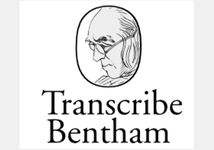Transcribe Bentham
Cs Portal > List of citizen science projects > Transcribe Bentham - (2013/09/25)
IDENTIFICATION
- Beta start date : N/A
- End date : Still open.
- Humanities > Literature (other)
- Others in the same subject areas: GeoTag-X
- Others projects about other: ARL crowd sourcing, CS4CS, ESP game, ReCaptcha
⇳ Description [[Has project description::Transcribe Bentham is a an award-winning participatory project based at University College London. Its aim is to engage the public in the online transcription of original and unstudied manuscript papers written by Jeremy Bentham (1748-1832), the great philosopher and reformer, via a transcription interface based on a customised MediaWiki. "Transcribe Bentham emerged out of initial discussions between Professor Philip Schofield, the Director of the Bentham Project, and Martin Moyle of UCL Library Services, regarding the production of a digital Bentham resource for a forthcoming Arts and Humanities Research Council funding call. Martin proposed the establishment of a resource to facilitate crowdsourced transcription of the Bentham Papers, and a potential partnership between the Bentham Project, UCL Library Services, UCL’s Centre for Digital Humanities, and the University of London Computer Centre. After an initial meeting between Professor Schofield, Martin, Dr Melissa Terras (UCL DH), and Richard Davis (ULCC), hosted by Library Services, the project consortium was formed."(About Us, official project page)]] ➠ Purpose Digital images of Jeremy Benthams’ published manuscripts are transcribed by volunteers to ensure long term preservation of the Philosophers works. ? Research question
TEAM
University College London, 26 Gordon Square, London, WC1.
Project team page http://blogs.ucl.ac.uk/transcribe-bentham/people/ Leader: Philip Schofield Institution: Partner institutions: Contact: transcribe.bentham@ucl.ac.uk
USER TASKS
CONTRIBUTION TYPE:
PARTICIPATION TYPOLOGY: crowdsourcing
GAMING GENRE NONE
GAMING ELEMENTS: Points
◉ Tasks description [[Has participant task description::The volunteer selects a manuscript, and is presented with a manuscript image alongside a free-text box, into which he or she enters their transcript (which can be saved at any time). Volunteers are also asked to add some basic formatting to their transcripts, and encode their work in Text-Encoding Initiative-compliant XML using a specially designed transcription toolbar. Using this, the volunteer can highlight a piece of text, or a position in the text, and click a button on the toolbar to identify a particular characteristic of that chosen portion. These include line breaks, paragraphs, unusual spellings, and frequent additions, deletions and marginalia present in the manuscripts. When a volunteer is happy with his or her transcript, it is submitted to Transcribe Bentham project staff for checking. From wikipedia]] ⤯ Interaction with objects Volunteer can see high-resolution images of original manuscript. It is possible to zoom into images. ▣ Interface
- Data type to manipulate: text
- interface enjoyment: rather not cool/attractive
- Interface usability: easy to use
GUIDANCE
- Tutorial: ✓
- Peer to peer guidance: Somewhat
- Training sequence: x
- Individual performance: ✓
- Collective performance: ✓
- Research progress: x
❂ Feedback and guidance description
COMMUNITY
- Communication:
- Social Network: Twitter, Facebook
- Member profiles:: N/A
- Member profile elements:
- Main news site: http://blogs.ucl.ac.uk/bentham-project/
- Frequency of project news updates: N/A
- Type of events: other
- Frequency of events :
⏣ Community description
- Community size (volounteers based)
- Role:
- Interaction form:
- Has official community manager(s): N/A
- Has team work N/A
- Other:
- Community led additions:
Other information
PROJECT
Url:http://www.ucl.ac.uk/Bentham-Project
Start date: 2010/09/08
End date: Still open
TEAM
Official team page:http://blogs.ucl.ac.uk/transcribe-bentham/people/
Leader: Philip Schofield
Contact: transcribe.bentham@ucl.ac.uk
Main location: University College London, 26 Gordon Square, London, WC1.
PROJECT DEFINITION
Subject
Humanities > Literature (other)
Description
Transcribe Bentham is a an award-winning participatory project based at University College London. Its aim is to engage the public in the online transcription of original and unstudied manuscript papers written by Jeremy Bentham (1748-1832), the great philosopher and reformer, via a transcription interface based on a customised MediaWiki. "Transcribe Bentham emerged out of initial discussions between Professor Philip Schofield, the Director of the Bentham Project, and Martin Moyle of UCL Library Services, regarding the production of a digital Bentham resource for a forthcoming Arts and Humanities Research Council funding call. Martin proposed the establishment of a resource to facilitate crowdsourced transcription of the Bentham Papers, and a potential partnership between the Bentham Project, UCL Library Services, UCL’s Centre for Digital Humanities, and the University of London Computer Centre. After an initial meeting between Professor Schofield, Martin, Dr Melissa Terras (UCL DH), and Richard Davis (ULCC), hosted by Library Services, the project consortium was formed."(About Us, official project page)
Purpose.
Digital images of Jeremy Benthams’ published manuscripts are transcribed by volunteers to ensure long term preservation of the Philosophers works.
.
ABOUT PARTICIPANT TASKS
Tasks description.
The volunteer selects a manuscript, and is presented with a manuscript image alongside a free-text box, into which he or she enters their transcript (which can be saved at any time). Volunteers are also asked to add some basic formatting to their transcripts, and encode their work in Text-Encoding Initiative-compliant XML using a specially designed transcription toolbar. Using this, the volunteer can highlight a piece of text, or a position in the text, and click a button on the toolbar to identify a particular characteristic of that chosen portion. These include line breaks, paragraphs, unusual spellings, and frequent additions, deletions and marginalia present in the manuscripts. When a volunteer is happy with his or her transcript, it is submitted to Transcribe Bentham project staff for checking. From wikipedia
Interaction with system objects.
Volunteer can see high-resolution images of original manuscript. It is possible to zoom into images.
| Grey typology | Participation typology | Contribution type: | ||||||||||||||||||||||||||||
|---|---|---|---|---|---|---|---|---|---|---|---|---|---|---|---|---|---|---|---|---|---|---|---|---|---|---|---|---|---|---|
|
|
|
||||||||||||||||||||||||||||
| Gaming | ||||||||||||||||||||||||||||||
| Genre: | Gaming elements: points | |||||||||||||||||||||||||||||
| Interface | ||||||||||||||||||||||||||||||
| Data type to manipulate: text | interface enjoyment: rather not cool/attractive Interface usability: easy to use |
Member profiles::N/A Member profile elements: |
||||||||||||||||||||||||||||
ABOUT GUIDANCE AND FEEDBACK
| Guidance | Feedback on | ||||||||||||
|---|---|---|---|---|---|---|---|---|---|---|---|---|---|
|
|
.
COMMUNITY
| Tools | News & Events |
|---|---|
|
Communication: |
Main news site: http://blogs.ucl.ac.uk/bentham-project/ |
| Community description | |
|
Community size (volounteers based): |
|
Other information about community:
Community led additions:
OTHER PROJECT INFORMATION
Bentham.jpg Yes [[has completion level::Low]
http://blogs.ucl.ac.uk/transcribe-bentham/people/
University College London, 26 Gordon Square, London, WC1. transcribe.bentham@ucl.ac.uk
Yes Literature Humanities other Digital images of Jeremy Benthams’ published manuscripts are transcribed by volunteers to ensure long term preservation of the Philosophers works.
Transcribe Bentham
[[Has participant task description::The volunteer selects a manuscript, and is presented with a manuscript image alongside a free-text box, into which he or she enters their transcript (which can be saved at any time). Volunteers are also asked to add some basic formatting to their transcripts, and encode their work in Text-Encoding Initiative-compliant XML using a specially designed transcription toolbar. Using this, the volunteer can highlight a piece of text, or a position in the text, and click a button on the toolbar to identify a particular characteristic of that chosen portion. These include line breaks, paragraphs, unusual spellings, and frequent additions, deletions and marginalia present in the manuscripts. When a volunteer is happy with his or her transcript, it is submitted to Transcribe Bentham project staff for checking. From wikipedia]]
crowdsourcing
text, other:
Thinking: yes
Computing: no
Sensing: no
Gaming: no
points
Volunteer can see high-resolution images of original manuscript. It is possible to zoom into images. rather not cool/attractive easy to use yes somewhat no yes yes no
N/A
N/A
Twitter, Facebook other
http://blogs.ucl.ac.uk/bentham-project/
N/A
N/A
Low
Volunteer Interviews
- Interview of volunteer by Kathleen. Volunteer talks about how it was satisfying to feel like you’re contributing to something. They liked the fact that the project was democratic in that anyone could get involved since the academic world can sometimes be a bit exclusive. Points earned from transcribing were another big motivator.
Other Info
- Project has been covered by many major international newspapers and radios and has won The Award of Distinction in the Digital Communities category of the Prix Ars Electronica- all creation a positive reputation for it in the community.
Assessment
- Volunteers seem more motivated to participate when it involves history. A few have made discoveries into the life of Jeremy Bentham through the transcribing of his manuscripts. The fact that they will be the first people to read these papers since he wrote them is enough to get them involved.
One volunteer described it as a ‘“literary form of archeology”. http://www.digitalhumanities.org/dhq/vol/6/2/000125/000125.html
Bibliography
| BIBLIOGRAPHY |



